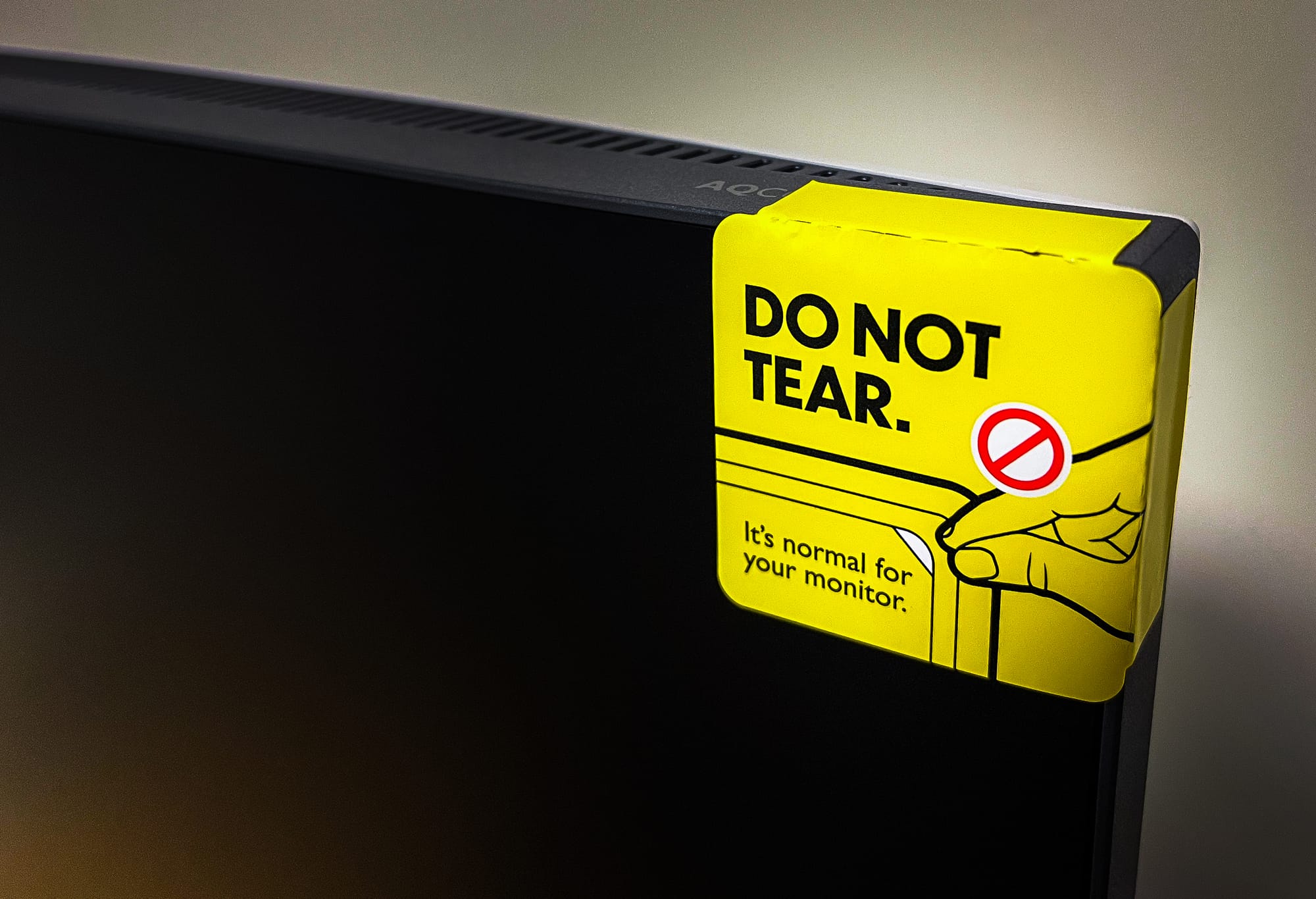Matte vs Glossy Screens: A Cautionary Tale

To understand my take on this topic, you have to know where I'm coming from — you must know my "screen-ethnicity".
My first computer was a 2007 MacBook, back when Apple offered white models and reserved the black ones for pros. I've since owned four others:
- 2008 (after a family member spilt orange juice on my first)
- 2012 (my first time using the Pro line and the retina display)
- 2017 (the where-are-all-the-ports generation, which I won't miss)
- 2023 (my first time using Apple Silicon, which still blows my mind)
Believe it or not, throughout this 18-year-long timeline, I hardly relied on an external monitor. I owned a 24-inch FHD in high school, and have since borrowed a 21:9 for a couple of editing projects, but that's it. For 18 years, I've made 13-inch screens suffice for the majority of my work.
The reason behind this … monitor celibacy? I didn't feel the need for one. And if I did, my thought bubble would pop upon realising I could get the work done without it and use the money for something else, like lenses.
Over the years, however, I've come to appreciate the extra real estate and the increase in productivity it translates to. At least, that's what they say …
5 years ago, I finally found myself in a position to buy a monitor. However, after studying the market, I abandoned the idea due to a lack of viable options. Lack of viable options? In 2020?! Yes, you see, I wasn't willing to trade my beloved retina display for anything. Like Hannah, I wanted the best of both worlds.
This meant I needed a 27-inch monitor with 5K resolution. At the time, there were only a handful of options, including Dell's UltraSharp, Philips' Brilliance, LG's UltraFine, and Apple's more-than-a-monitor iMac. A 32-inch retina solution was also a dead end. There was only one back then — Apple's Pro XDR Display — which cost about as much as all the MacBooks I had owned combined.
It wasn't until a few years later, after Apple announced the Studio Display, that display manufacturers jumped on the retina bandwagon, including Samsung's ViewFinity S9 in 2023, ASUS' ProArt PA27JCV in 2024, and BenQ's PD2730S in 2025. This last one rekindled my monitor spree.
And that's how — yesterday — I made my first fully confident premium monitor purchase. Except I wasn't fully confident. I overlooked one major aspect: screen types. The oversight was two-fold. Firstly, I hadn't stopped to check what screen type I was used to (the one all my MacBooks had). The answer I now know — a little too late — is glossy. Secondly, as a byproduct, I didn't study the screen that my target monitor featured. The answer I now know — a little too late — is matte.
Now, it's nothing to boast about, but oversights like this rarely happen to me. Ask my wife and she'll tell you that I turn into a tech maniac when benchmarking my next big purchase and refuse to commit to it until I've considered every option — and sub-option — by which point I'll have "analysis paralysis", which sometimes jeopardises the purchase altogether.
Back to my new monitor. I'm looking at its matte screen as I type these words, so let me try my best to describe its quality:
frosted · paper-like · diffused · grainy/sparkly · soft
It's funny because when I unboxed the monitor, it had a yellow sticker in the top-right corner of the screen that read the following:
DO NOT TEAR. It's normal for your monitor.
And yet, as I tested the device for the first 10 minutes, all I could think was: Why on earth did they cover the screen with baking foil?!
… It's a big change for someone like me who has only ever known glossy screens. Here's how I'd describe those:
sharp · clean · glaced · vivid/vibrant · perfect · modern
To clarify, it's not that I didn't know my monitor packed a matte screen. I just didn't make much of that fact. I didn't think it would be any different from what I was used to — again, not knowing what I was used to. In fact, given the budget I was prepared to invest, I thought the screen would be an improvement no matter what: Oh, it even counteracts glare and reflections? Cool bonus feature!
If you search the pro designer monitor market, you'll find out that the standard is matte screens. Very few offer glossy, because they assume most professionals will be inside offices, surrounded by windows, ceiling lights, and other monitors. BenQ's entire PD line ("Pro Designer") features matte surfaces. They even wrote an article about the two screen types, clearly favouring matte screens.
Apple is one of the few that offer pro designer monitors with a glossy surface. The irony? They charge extra for their nano-textured monitors (matte) option, giving the impression that matte is superior.
As a result of this blunder, I now have mixed feelings about my purchase. It's not that I don't find the screen sharp, it's just that I'm used to the crystal-clear, non-filtered quality of glossy screens. Granted, I hardly notice the matte quality when I'm watching a video in full screen. But anything that's a solid colour — like a text document or a piece of UI — I can't help but get distracted by the texture.
… God, I just remembered something: A comment on a Reddit thread I came across during my research. At the time, I didn't make much of it, but for some reason, it decided to hibernate inside me, only to resurface now … with menace. The person said he didn't understand all the fuss with matte screens, stating they vehemently disliked them for their inherent textured look — "period".
This is a good time to address the elephant in the essay: The big selling point of matte screens is that they minimise reflections, which can distract, hinder work, and cause eye fatigue. The thing is, after living in "glossyland" for almost two decades, this never bothered me. I've always ended up in relatively closed spaces without light hazards. And when I didn't, I'd draw the curtains or budge.
Now, I recognise that not everyone can relate to that kind of … luck? Moreover, if I end up having to work in an open office space surrounded by curtainless windows, studio lights, and screens, I'll have no choice but to go down the matte path. But so far — and right now — I frankly don't require these commodities.
So, do I regret my purchase? Not entirely. I'm in a weird spot. On the one hand, I'm excited about the monitor and its bells and whistles, such as retina, colour accuracy, Thunderbolt 4, 90-degree rotation, and a wireless puck for easy control. On the other hand, I can't look at my screen for too long before noticing the icy quality, pseudo-sparkling, and the echoing words of that blunt Redditor.
I'm not sure if my reaction is normal or if I'm sensitive to these things. Then again, it's only my second day dealing with the switch. Perhaps it'll get better. Who knows, maybe in a month, I'll move into an open office, and this essay will have aged like milk. Or things will go the other way, forcing me to sell and settle for a pricy glossy option from Apple. My path appears to be doomed no matter what …
For now, I'll keep an open mind and give the matte world a chance. Whether I succumb to or overcome these mixed feelings, only time will tell. In a few months, I'll add a note at the end of the essay with an update to this case.
To conclude, dear reader, if you're in the market for a new monitor, before spending your hard-earned money, make sure to cover the following tasks:
- Know the screen type you're used to.
- Know the screen type you're not used to.
- Decide with (true) confidence.
I failed at all three and now find myself in a PPP — "post-purchase predicament". Don't fall into the same trap. Discover what you're using, test the alternative, and choose wisely. (It didn't help that I live in Iceland, a country without device variety or stock. In fact, I had to blind-buy the monitor as it was a "special order".)
Of course, you're welcome to disregard everything I've said, fail on purpose, and join me on this wild ride. This is, after all, a trivial quandary.

